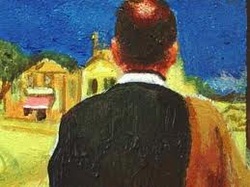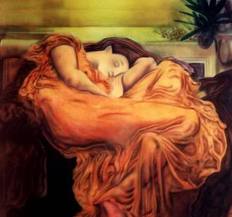
“That’s where I grew up,” Grandpa used to say, pointing at the old painting on the living room wall. “All those years, growing up with five other siblings in one small room.” He’d then describe bits and pieces of his youth, jumping from subject to subject, all without taking his eyes off of the painting of the yellow wooden house.
We’d seen the house he grew up in— it wasn’t wooden, nor was it located on a hill in the middle of a forest. So every time he started talking about the house in the painting, we diverted our attention elsewhere and found subjects that we could all relate to, like Cousin Betty’s wedding or Uncle Roy’s new wife. As we all sat chatting around the coffee table after the weekly family dinners, he often stared at the yellow house, his chair pulled up close to the wall, his body leaning forward as though examining an organism under a microscope.
When Grandpa got sick, we had to take him to his bedroom and visit him there. Dad placed flowers at every corner of the room; Mom changed their water every day to keep them alive. My uncles and aunts bought him a flat-screen TV that had twice as many channels as the one we had at home. But Grandpa remained uninterested. The constant smile on his lips was gone. He wasn’t always aware of who was in the room or what new present he received, but he seemed well aware of the inescapable.
Weeks before his death, I managed to hang up the painting on the wall facing his bed and watched his face light up with joy at the sight of the house. “That’s where you grew up,” I told him before he had a chance to say it out loud. For the first time in months, he looked me straight in the eye, nodding. “Six brothers in one small room,” he added. He went on, and I sat there next to his bed, filling in the details that he’d told us before, helping him tell the whole story the way he wanted it to be heard. LS
We’d seen the house he grew up in— it wasn’t wooden, nor was it located on a hill in the middle of a forest. So every time he started talking about the house in the painting, we diverted our attention elsewhere and found subjects that we could all relate to, like Cousin Betty’s wedding or Uncle Roy’s new wife. As we all sat chatting around the coffee table after the weekly family dinners, he often stared at the yellow house, his chair pulled up close to the wall, his body leaning forward as though examining an organism under a microscope.
When Grandpa got sick, we had to take him to his bedroom and visit him there. Dad placed flowers at every corner of the room; Mom changed their water every day to keep them alive. My uncles and aunts bought him a flat-screen TV that had twice as many channels as the one we had at home. But Grandpa remained uninterested. The constant smile on his lips was gone. He wasn’t always aware of who was in the room or what new present he received, but he seemed well aware of the inescapable.
Weeks before his death, I managed to hang up the painting on the wall facing his bed and watched his face light up with joy at the sight of the house. “That’s where you grew up,” I told him before he had a chance to say it out loud. For the first time in months, he looked me straight in the eye, nodding. “Six brothers in one small room,” he added. He went on, and I sat there next to his bed, filling in the details that he’d told us before, helping him tell the whole story the way he wanted it to be heard. LS



 RSS Feed
RSS Feed